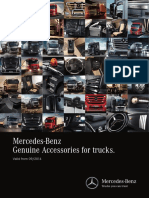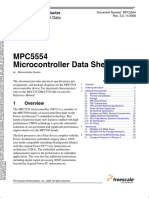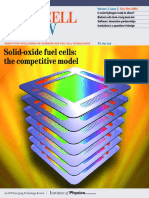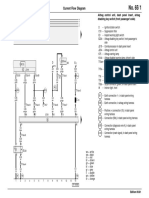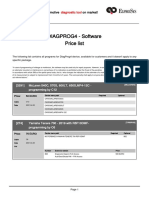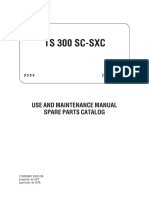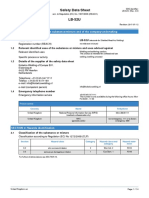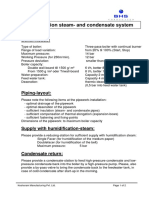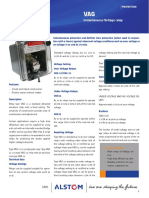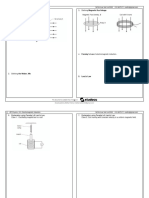Safety Data Sheet TGX-2209: SECTION 1: Identification of The Substance/mixture and of The Company/undertaking
Safety Data Sheet TGX-2209: SECTION 1: Identification of The Substance/mixture and of The Company/undertaking
Uploaded by
V U P RaoCopyright:
Available Formats
Safety Data Sheet TGX-2209: SECTION 1: Identification of The Substance/mixture and of The Company/undertaking
Safety Data Sheet TGX-2209: SECTION 1: Identification of The Substance/mixture and of The Company/undertaking
Uploaded by
V U P RaoOriginal Title
Copyright
Available Formats
Share this document
Did you find this document useful?
Is this content inappropriate?
Copyright:
Available Formats
Safety Data Sheet TGX-2209: SECTION 1: Identification of The Substance/mixture and of The Company/undertaking
Safety Data Sheet TGX-2209: SECTION 1: Identification of The Substance/mixture and of The Company/undertaking
Uploaded by
V U P RaoCopyright:
Available Formats
SDS identifier:
Safety Data Sheet TGX-2209: (Rev. 2.0)
according to Regulation (EC) No. 1907/2006 (REACH)
TGX-2209
Version number: 2.0 Revision: 2017-09-12
Replaces version of: 2014-03-19 (1)
SECTION 1: Identification of the substance/mixture and of the company/undertaking
1.1 Product identifier
Trade name TGX-2209 (electrode for Gas Tungsten Arc Welding)
Registration number (REACH) not relevant (mixture)
1.2 Relevant identified uses of the substance or mixture and uses advised against
Relevant identified uses Welding and soldering product
The product is intended for professional use
Specific process or activity welding (welding process)
1.3 Details of the supplier of the safety data sheet
Kobelco Welding of Europe B.V.
Eisterweg 8
6422 PN Heerlen
Netherlands
Telephone: +31(0)45-5471111
Telefax: +31(0)45-5471100
e-mail: info@kobelcowelding.nl
e-mail (competent person) info@kobelcowelding.nl
1.4 Emergency telephone number
Emergency information service +31(0)45-5471111
This number is only available during the following office hours: Mon-
Fri 09:00 - 17:00
Poison centre
Country Name Telephone
United Kingdom National Poisons Information Service (NPIS) 0344-8920111
(medical professionals only)
United Kingdom NHS non-emergency: 111 or a doctor;
(general public) emergency: 999
SECTION 2: Hazards identification
2.1 Classification of the substance or mixture
Classification according to Regulation (EC) No 1272/2008 (CLP)
Section Hazard class Category Hazard class and Hazard state-
category ment
3.3 serious eye damage/eye irritation 2 Eye Irrit. 2 H319
3.4S skin sensitisation 1 Skin Sens. 1 H317
3.6 carcinogenicity 2 Carc. 2 H351
3.9 specific target organ toxicity - repeated exposure 1 STOT RE 1 H372
United Kingdom: en Page: 1 / 16
SDS identifier:
Safety Data Sheet TGX-2209: (Rev. 2.0)
according to Regulation (EC) No. 1907/2006 (REACH)
TGX-2209
Version number: 2.0 Revision: 2017-09-12
Replaces version of: 2014-03-19 (1)
For full text of abbreviations: see SECTION 16.
The most important adverse physicochemical, human health and environmental effects
Delayed or immediate effects can be expected after short or long-term exposure.
2.2 Label elements
Labelling according to Regulation (EC) No 1272/2008 (CLP)
- signal word danger
- pictograms
GHS07, GHS08
- hazard statements
H317 May cause an allergic skin reaction.
H319 Causes serious eye irritation.
H351 Suspected of causing cancer.
H372 Causes damage to organs through prolonged or repeated exposure.
- precautionary statements
P260 Do not breathe dust/fume/gas/mist/vapours/spray.
P280 Wear protective gloves/protective clothing/eye protection/face protection.
P305+P351+P338 IF IN EYES: Rinse cautiously with water for several minutes. Remove contact lenses, if present and
easy to do. Continue rinsing.
P308+P313 IF exposed or concerned: Get medical advice/attention.
P314 Get medical advice/attention if you feel unwell.
P333+P313 If skin irritation or rash occurs: Get medical advice/attention.
P337+P313 If eye irritation persists: Get medical advice/attention.
P501 Dispose of contents/container in accordance with local/regional/national/international regulations.
- hazardous ingredients for labelling Nickel
2.3 Other hazards
Avoid breathing dust. Avoid contact with eyes. Avoid skin contact.
When this product is used in a welding process, the most significant hazards are electric shock, fumes, gases, radiation, spatter,
slag and heat.
Shock: electric shock can kill.
Fumes: Overexposure to welding fumes may result in symptoms like dizziness, nausea, dryness or irritation of the nose, throat or
eyes. Chronic overexposure to welding fumes may affect pulmonary function.
Gases: gases may cause gas poisoning.
Radiation: arc rays can severely damage eyes or skin.
Spatter, slag and heat: spatter and slag can damage eyes. Spatter, slag, melting material, arc rays and hot welds can cause
burn injuries and start fires.
Results of PBT and vPvB assessment
This mixture does not contain any substances that are assessed to be a PBT or a vPvB.
SECTION 3: Composition/information on ingredients
3.1 Substances
Not relevant (mixture)
3.2 Mixtures
The product does not contain any (other) ingredients which are classified according to present knowledge of the supplier and
contribute to the classification of the substance and hence require reporting in this section.
United Kingdom: en Page: 2 / 16
SDS identifier:
Safety Data Sheet TGX-2209: (Rev. 2.0)
according to Regulation (EC) No. 1907/2006 (REACH)
TGX-2209
Version number: 2.0 Revision: 2017-09-12
Replaces version of: 2014-03-19 (1)
Name of sub- Identifier Wt% Classification Picto- Notes Specific M-Factors
stance acc. to GHS grams Conc. Limits
Chromium CAS No 13 – 33 IOELV
7440-47-3
EC No
231-157-5
REACH Reg.
No
01-
2119485652
-31-xxxx
Nickel CAS No 3 – 13 Skin Sens. 1 / IARC:
7440-02-0 H317 2B
Carc. 2 / H351
EC No STOT RE 1 / H372
231-111-4 Aquatic Chronic 3 /
H412
REACH Reg.
No
01-
2119438727
-29-xxxx
calcium oxide CAS No ≤ 1 Skin Irrit. 2 / H315
1305-78-8 Eye Dam. 1 / H318
STOT SE 3 / H335
EC No
215-138-9
REACH Reg.
No
01-
2119475325
-36-xxxx
Notes
IARC: IARC group 2B: possibly carcinogenic to humans (International Agency for Research on Cancer)
2B:
IOELV: Substance with a community indicative occupational exposure limit value
Remarks
For full text of H-phrases: see SECTION 16. All the percentages given are percentages by weight unless stated otherwise.
SECTION 4: First aid measures
4.1 Description of first aid measures
General notes
Do not leave affected person unattended. Remove victim out of the danger area. Keep affected person warm, still and covered.
Take off immediately all contaminated clothing. In all cases of doubt, or when symptoms persist, seek medical advice. In case
of unconsciousness place person in the recovery position. Never give anything by mouth. Disconnect and turn off the power. If
the victim is semi- or unconscious, open the airway. If the victim cannot breath, give artificial respiration. If there is no pulse, mas-
sage the chest and apply artificial respiration.
Electrical shock
Disconnect and turn off the power. If the victim is semi- or unconscious, open the airway. If the victim cannot breath, give artifi-
cial respiration. If there is no pulse, massage the chest and apply artificial respiration.
United Kingdom: en Page: 3 / 16
SDS identifier:
Safety Data Sheet TGX-2209: (Rev. 2.0)
according to Regulation (EC) No. 1907/2006 (REACH)
TGX-2209
Version number: 2.0 Revision: 2017-09-12
Replaces version of: 2014-03-19 (1)
Following inhalation
Provide fresh air. If breathing is irregular or stopped, immediately seek medical assistance and start first aid actions. If experien-
cing respiratory symptoms: Call a doctor.
Following skin contact
Rinse skin with water/shower.
Following eye contact
Remove contact lenses, if present and easy to do. Continue rinsing. Irrigate copiously with clean, fresh water for at least 15
minutes, holding the eyelids apart.
Following ingestion
Rinse mouth with water (only if the person is conscious). Do NOT induce vomiting. Call a POISON CENTER or doctor if you feel
unwell.
4.2 Most important symptoms and effects, both acute and delayed
No further relevant information available.
4.3 Indication of any immediate medical attention and special treatment needed
For specialist advice physicians should contact the poison centre.
SECTION 5: Firefighting measures
5.1 Extinguishing media
Suitable extinguishing media
Alcohol resistant foam, Dry extinguishing powder, Carbon dioxide (CO2), Water spray
5.2 Special hazards arising from the substance or mixture
No further relevant information available.
Hazardous combustion products
During fire hazardous fumes/smoke could be produced.
5.3 Advice for firefighters
In case of fire and/or explosion do not breathe fumes. Co-ordinate firefighting measures to the fire surroundings. Do not allow
firefighting water to enter drains or water courses. Collect contaminated firefighting water separately. Fight fire with normal pre-
cautions from a reasonable distance.
Special protective equipment for firefighters
Self-contained breathing apparatus (EN 133). Standard protective clothing for firefighters.
SECTION 6: Accidental release measures
6.1 Personal precautions, protective equipment and emergency procedures
For non-emergency personnel
Remove persons to safety.
For emergency responders
Wear breathing apparatus if exposed to vapours/dust/spray/gases. Use personal protective equipment as required.
6.2 Environmental precautions
Keep away from drains, surface and ground water. Retain contaminated washing water and dispose of it.
United Kingdom: en Page: 4 / 16
SDS identifier:
Safety Data Sheet TGX-2209: (Rev. 2.0)
according to Regulation (EC) No. 1907/2006 (REACH)
TGX-2209
Version number: 2.0 Revision: 2017-09-12
Replaces version of: 2014-03-19 (1)
6.3 Methods and material for containment and cleaning up
Advices on how to contain a spill
Covering of drains. Take up mechanically.
Advices on how to clean up a spill
Take up mechanically.
Other information relating to spills and releases
Place in appropriate containers for disposal. Ventilate affected area.
6.4 Reference to other sections
Hazardous combustion products: see section 5. Personal protective equipment: see section 8. Incompatible materials: see sec-
tion 10. Disposal considerations: see section 13.
SECTION 7: Handling and storage
7.1 Precautions for safe handling
Keep away from fire.
Recommendations
- measures to prevent fire as well as aerosol and dust generation
No special measures are necessary.
Advice on general occupational hygiene
Wash hands after use. Do not eat, drink and smoke in work areas. Remove contaminated clothing and protective equipment be-
fore entering eating areas. Never keep food or drink in the vicinity of chemicals. Never place chemicals in containers that are
normally used for food or drink. Keep away from food, drink and animal feedingstuffs.
7.2 Conditions for safe storage, including any incompatibilities
Managing of associated risks
- explosive atmospheres
Removal of dust deposits.
- flammability hazards
Keep away from fire. Keep away from combustible material.
- incompatible substances or mixtures
Acids, Alkalis, Oxidisers
Control of effects
Protect against external exposure, such as
High temperatures, Humidity
Consideration of other advice
Store in a well-ventilated place. Keep container tightly closed.
- general rule
Store welding consumables inside a room without humidity. Do not store welding consumables directly on the ground or beside a
wall. Keep welding consumables away from chemical substances like acids which could cause chemical reactions.
- ventilation requirements
Use local and general ventilation.
United Kingdom: en Page: 5 / 16
SDS identifier:
Safety Data Sheet TGX-2209: (Rev. 2.0)
according to Regulation (EC) No. 1907/2006 (REACH)
TGX-2209
Version number: 2.0 Revision: 2017-09-12
Replaces version of: 2014-03-19 (1)
7.3 Specific end use(s)
Welding (welding process).
SECTION 8: Exposure controls/personal protection
8.1 Control parameters
National limit values
Occupational exposure limit values (Workplace Exposure Limits)
Cou Name of agent CAS No Nota- Identi- TWA TWA STEL STEL Source
ntry tion fier [ppm] [mg/m³] [ppm] [mg/m³]
EU calcium oxide 1305-78-8 r IOELV 1 4 2017/164/E
U
EU manganese 7439-96-5 i IOELV 0.2 2017/164/E
U
EU chromium 7440-47-3 IOELV 2 2017/164/E
U
GB dust i WEL 10 EH40/2005
GB dust r WEL 4 EH40/2005
GB calcium oxide 1305-78-8 WEL 2 EH40/2005
GB aluminium oxides 1344-28-1 i WEL 10 EH40/2005
GB aluminium oxides 1344-28-1 r WEL 4 EH40/2005
GB titanium dioxide 13463-67-7 i WEL 10 EH40/2005
GB titanium dioxide 13463-67-7 r WEL 4 EH40/2005
GB manganese 7439-96-5 WEL 0.5 EH40/2005
GB nickel 7440-02-0 WEL 0.1 EH40/2005
GB silicon 7440-21-3 i WEL 10 EH40/2005
GB silicon 7440-21-3 r WEL 4 EH40/2005
GB chromium 7440-47-3 WEL 0.5 EH40/2005
GB silica, amorphous 7631-86-9 i WEL 6 EH40/2005
GB silica, amorphous 7631-86-9 r WEL 2.4 EH40/2005
Notation
i inhalable fraction
r respirable fraction
STEL short-term exposure limit: a limit value above which exposure should not occur and which is related to a 15-minute period unless oth-
erwise specified
TWA time-weighted average (long-term exposure limit): measured or calculated in relation to a reference period of 8 hours time-weighted
average
Relevant DNELs/DMELs/PNECs and other threshold levels
Relevant DNELs of components of the mixture
Name of substance CAS No End- Threshold Protection goal, Used in Exposure time
point level route of exposure
Chromium 7440-47-3 DNEL 0.5 mg/m³ human, inhalatory worker (industry) chronic - local ef-
fects
Nickel 7440-02-0 DNEL 0.05 mg/m³ human, inhalatory worker (industry) chronic - local ef-
fects
United Kingdom: en Page: 6 / 16
SDS identifier:
Safety Data Sheet TGX-2209: (Rev. 2.0)
according to Regulation (EC) No. 1907/2006 (REACH)
TGX-2209
Version number: 2.0 Revision: 2017-09-12
Replaces version of: 2014-03-19 (1)
Relevant DNELs of components of the mixture
Name of substance CAS No End- Threshold Protection goal, Used in Exposure time
point level route of exposure
Nickel 7440-02-0 DNEL 0.05 mg/m³ human, inhalatory worker (industry) chronic - systemic
effects
Nickel 7440-02-0 DNEL 0.05 mg/m³ human, inhalatory worker (industry) acute - systemic
effects
Nickel 7440-02-0 DNEL 4 mg/m³ human, inhalatory worker (industry) acute - local ef-
fects
calcium oxide 1305-78-8 DNEL 4 mg/m³ human, inhalatory worker (industry) acute - local ef-
fects
calcium oxide 1305-78-8 DNEL 1 mg/m³ human, inhalatory worker (industry) chronic - local ef-
fects
Relevant PNECs of components of the mixture
Name of substance CAS No End- Threshold Organism Environmental Exposure time
point level compartment
Chromium 7440-47-3 PNEC 6.5 µg/l aquatic organisms freshwater short-term (single
instance)
Chromium 7440-47-3 PNEC 205.7 mg/kg aquatic organisms freshwater sedi- short-term (single
ment instance)
Chromium 7440-47-3 PNEC 21.1 mg/kg terrestrial organisms soil short-term (single
instance)
calcium oxide 1305-78-8 PNEC 0.37 mg/l aquatic organisms freshwater short-term (single
instance)
calcium oxide 1305-78-8 PNEC 0.24 mg/l aquatic organisms marine water short-term (single
instance)
calcium oxide 1305-78-8 PNEC 2.27 mg/l aquatic organisms sewage treatment short-term (single
plant (STP) instance)
calcium oxide 1305-78-8 PNEC 817.4 mg/kg terrestrial organisms soil short-term (single
instance)
calcium oxide 1305-78-8 PNEC 0.37 mg/l aquatic organisms water intermittent re-
lease
8.2 Exposure controls
Appropriate engineering controls
Use enough ventilation, local exhaust at the arc, or both, to keep the fumes and gases below the TLVs in the worker’s breathing
zone and the general area. Use extra ventilation when welding galvanized plate or coated plate.
Individual protection measures (personal protective equipment)
Eye/face protection
Wear helmet or use face shield with filter lens. As a rule of thumb, start with a shade which is too dark to see the weld zone. Then
go to the next lighter shade which gives sufficient view of the weld zone. Provide protective screens and flash goggles, if neces-
sary, to shield others.
United Kingdom: en Page: 7 / 16
SDS identifier:
Safety Data Sheet TGX-2209: (Rev. 2.0)
according to Regulation (EC) No. 1907/2006 (REACH)
TGX-2209
Version number: 2.0 Revision: 2017-09-12
Replaces version of: 2014-03-19 (1)
Skin protection
Protective clothing (EN 340).
- hand protection
Welding gloves according to EN12477:2001 and A1:2005 in case of arc welding. For special purposes, it is recommended to
check the resistance to chemicals of the protective gloves mentioned above together with the supplier of these gloves. The ex-
act break through time should be requested at the protective glove manufacturer and must be observed.
- breakthrough times of the glove material
>480 minutes (permeation: level 6).
- other protection measures
Take recovery periods for skin regeneration. Preventive skin protection (barrier creams/ointments) is recommended. Wash
hands thoroughly after handling. Wear head, hand and bodyprotection which help to prevent injury form radiation, sparks and
electric shock. At a m inimum this includes welder's gloves and protective face shield and may include arm protectors, aprons,
hats, shoulder protection as well as dark substantial clothing.
Train the welder not to touch live electrical parts and to insulate himself from work and ground.
Respiratory protection
Use respirable fume respirator or air supplied respirator when welding in confined space or where local exhaust or ventilation
does not keep exposure below TLV. Keep head out of the fumes and gases.
Ear protection
Wear earplugs or earmuffs when using engine driven arc welding machine or pulsed arc welding machine that generates high-
level noise.
Environmental exposure controls
Use appropriate container to avoid environmental contamination. Keep away from drains, surface and ground water.
SECTION 9: Physical and chemical properties
9.1 Information on basic physical and chemical properties
Appearance
Physical state solid (electrode)
Colour grey
Odour odourless
Other safety parameters
pH (value) not applicable
Melting point/freezing point not determined
Initial boiling point and boiling range not determined
Flash point not applicable
Evaporation rate not determined
Flammability (solid, gas) non-combustible
United Kingdom: en Page: 8 / 16
SDS identifier:
Safety Data Sheet TGX-2209: (Rev. 2.0)
according to Regulation (EC) No. 1907/2006 (REACH)
TGX-2209
Version number: 2.0 Revision: 2017-09-12
Replaces version of: 2014-03-19 (1)
Explosion limits of dust clouds not determined
Vapour pressure not determined
Density not determined
Vapour density this information is not available
Relative density information on this property is not available
Solubility(ies) not determined
Partition coefficient
- n-octanol/water (log KOW) this information is not available
Auto-ignition temperature information on this property is not available
Viscosity not relevant (solid matter)
Explosive properties none
Oxidising properties none
9.2 Other information
Of no significance.
SECTION 10: Stability and reactivity
10.1 Reactivity
Contact with chemical substances could cause generation of gas.
10.2 Chemical stability
See below "Conditions to avoid".
10.3 Possibility of hazardous reactions
Reacts with:. Acids. Alkalis. Oxidising substances.
10.4 Conditions to avoid
Keep away from heat.
10.5 Incompatible materials
Oxidisers, Acids, Alkalis
10.6 Hazardous decomposition products
Reasonably anticipated hazardous decomposition products produced as a result of use, storage, spill and heating are not
known. Hazardous decomposition products includes those from the volatilization, reaction or oxidation of the material listed in
section 3 and those from the base metal and coating. Manganese has a low exposure limit, in some countries, that may be eas-
ily exceeded. Reasonably expected gaseous products would include carbon oxides, nitrogen oxides and ozone. Reasonably ex-
pected fume constituents of this product would include oxides of metals
United Kingdom: en Page: 9 / 16
SDS identifier:
Safety Data Sheet TGX-2209: (Rev. 2.0)
according to Regulation (EC) No. 1907/2006 (REACH)
TGX-2209
Version number: 2.0 Revision: 2017-09-12
Replaces version of: 2014-03-19 (1)
SECTION 11: Toxicological information
11.1 Information on toxicological effects
Inhalation of welding fumes and gases can be dangerous to your health. The composition and quantity of both are dependent
upon the material being worked, the process, procedures and consumables used.
Classification procedure
The method for classification of the mixture is based on ingredients of the mixture (additivity formula).
Classification according to GHS (1272/2008/EC, CLP)
Acute toxicity
Overexposure to gases, fumes and dusts may inclide irritation of the eyes, lungs, nose and throat. Some toxic gases (associ-
ated with welding) may cause pulmonary edema, asphyxiation and death. Acute overexposure may include signs and symp-
toms such as watery eyes, nose and throat irritation, headache, dizziness, difficulty in breathing, frequent coughing or chest pain.
Exposure to the fluoride ion may cause hypocalcaemia-calcium deficiency in the blood that can result in muscle cramps and in-
flammation and necrosis of mucous membranes.
- acute toxicity of components of the mixture
Acute toxicity of components of the mixture
Name of substance CAS No Exposure Endpoint Value Species
route
Nickel 7440-02-0 oral LD50 >9,000 mg/kg rat
calcium oxide 1305-78-8 oral LD50 >2,000 mg/ rat
kg
Skin corrosion/irritation
Shall not be classified as corrosive/irritant to skin.
Serious eye damage/eye irritation
Causes serious eye irritation.
Respiratory or skin sensitisation
May cause an allergic skin reaction.
Germ cell mutagenicity
Shall not be classified as germ cell mutagenic.
Carcinogenicity
Suspected of causing cancer.
IARC Monographs on the Evaluation of Carcinogenic Risks to Humans
Name of substance CAS No Wt% Classification Remarks Number Date indica-
tion
nickel powder (particle dia- 7440-02-0 13 2B Volume 49 1990
meter < 1mm)
Chromium 7440-47-3 33 3 Volume 49 1990
Legend
2B Possibly carcinogenic to humans
3 Not classifiable as to carcinogenicity in humans
United Kingdom: en Page: 10 / 16
SDS identifier:
Safety Data Sheet TGX-2209: (Rev. 2.0)
according to Regulation (EC) No. 1907/2006 (REACH)
TGX-2209
Version number: 2.0 Revision: 2017-09-12
Replaces version of: 2014-03-19 (1)
Reproductive toxicity
Shall not be classified as a reproductive toxicant.
Summary of evaluation of the CMR properties
Nickel is considered carcinogenic. Long term overexplosure to nickel fumes may also cause pulmonary fibrosis and oedema.
Welding fumes (not otherwise specified) are possibly carcinogenic to humans.
Specific target organ toxicity - repeated exposure
Causes damage to organs through prolonged or repeated exposure. Nickel is considered carcinogenic. Long term overexplos-
ure to nickel fumes may also cause pulmonary fibrosis and oedema. Overexposure to air contaminants may lead to their accu-
mulation in the lungs, a condition which may be seen as dense areas on chest X-rays. The severity of the change is proportional
to the length of the exposure. The changes may be caused by non-work factors such as smoking, etc. Long term exposure to
welding and allied processes gasses, dusts and fumes may contribute to pulmonary irritation or pneumoconiosis. Overexposure
to manganese compounds may affect the central nervous system, symptoms of which are languor, sleepiness, muscular weak-
ness, emotional disturbances and spastic gait. The effect of manganese on the nervous systeem is irreversible. Inhalation of to
much iron oxide fume over a long time can cause siderosis, sometimes called "iron pigmentation"of the lung, which can be seen
on a cest x-ray but causes little or no disability. Chronic overexposure to iron (>50-100 mg Fe per day) can result in pathological
deposition of iron in body tissues of which are firbrosis of the pancreas, diabetes mellitus and lever cirrhosis. Chronic fluoride ab-
sorption can result in osseous fluor sis, increased radiographic density of the bones and mottling of the teeth. Chromium (in
some forms) is considered carcinogenic. Chromium compounds have a corrosive action on the skin and mucous membranes
and forms lesions on exposed skin and the nasal septum. Liver damage and allergic skin rash have also been reported.
Aspiration hazard
Shall not be classified as presenting an aspiration hazard.
SECTION 12: Ecological information
12.1 Toxicity
Shall not be classified as hazardous to the aquatic environment.
Aquatic toxicity (acute) of components of the mixture
Name of substance CAS No Endpoint Value Species Exposure
time
Nickel 7440-02-0 LC50 15.3 mg/l fish 96 h
Nickel 7440-02-0 EC50 561.3 µg/l aquatic invertebrates 96 h
Nickel 7440-02-0 ErC50 <148 µg/l algae 72 h
Aquatic toxicity (chronic) of components of the mixture
Name of substance CAS No Endpoint Value Species Exposure
time
Nickel 7440-02-0 ErC50 8,363 µg/l fish 40 d
Nickel 7440-02-0 LC50 204 µg/ aquatic invertebrates 21 d
l
Nickel 7440-02-0 EbC50 6.2 µg/l aquatic invertebrates 30 d
Nickel 7440-02-0 EC50 406 µg/ aquatic invertebrates 24 h
l
12.2 Persistence and degradability
No further relevant information available.
United Kingdom: en Page: 11 / 16
SDS identifier:
Safety Data Sheet TGX-2209: (Rev. 2.0)
according to Regulation (EC) No. 1907/2006 (REACH)
TGX-2209
Version number: 2.0 Revision: 2017-09-12
Replaces version of: 2014-03-19 (1)
12.3 Bioaccumulative potential
No further relevant information available.
12.4 Mobility in soil
Not mobile.
12.5 Results of PBT and vPvB assessment
This mixture does not contain any substances that are assessed to be a PBT or a vPvB.
12.6 Other adverse effects
No further relevant information available.
Endocrine disrupting potential
None of the ingredients are listed.
SECTION 13: Disposal considerations
13.1 Waste treatment methods
Sewage disposal-relevant information
Do not empty into drains. Avoid release to the environment.
Waste treatment of containers/packagings
Handle contaminated packages in the same way as the substance itself.
Remarks
Please consider the relevant national or regional provisions. Waste shall be separated into the categories that can be handled
separately by the local or national waste management facilities.
SECTION 14: Transport information
14.1 UN number not subject to transport regulations
14.2 UN proper shipping name not relevant
14.3 Transport hazard class(es) none
14.4 Packing group not relevant
14.5 Environmental hazards non-environmentally hazardous acc. to the dangerous goods regu-
lations
14.6 Special precautions for user
There is no additional information.
14.7 Transport in bulk according to Annex II of MARPOL and the IBC Code
No data available.
Information for each of the UN Model Regulations
Transport of dangerous goods by road, rail and inland waterway (ADR/RID/ADN)
Not subject to ADR, RID and ADN.
International Maritime Dangerous Goods Code (IMDG)
Not subject to IMDG.
United Kingdom: en Page: 12 / 16
SDS identifier:
Safety Data Sheet TGX-2209: (Rev. 2.0)
according to Regulation (EC) No. 1907/2006 (REACH)
TGX-2209
Version number: 2.0 Revision: 2017-09-12
Replaces version of: 2014-03-19 (1)
International Civil Aviation Organization (ICAO-IATA/DGR)
Not subject to ICAO-IATA.
SECTION 15: Regulatory information
15.1 Safety, health and environmental regulations/legislation specific for the substance or mixture
Relevant provisions of the European Union (EU)
Restrictions according to REACH, Annex XVII
Dangerous substances with restrictions (REACH, Annex XVII)
Name of substance Name acc. to inventory CAS No Type of registra- Restriction No
tion
nickel powder (particle diameter nickel 7440-02- 1907/2006/EC annex R27 27
< 1mm) 0 XVII
Legend
R27 1. Shall not be used:
(a) in any post assemblies which are inserted into pierced ears and other pierced parts of the human body unless the rate of nickel re-
lease from such post assemblies is less than 0,2 μg/cm2/week (migration limit);
(b) in articles intended to come into direct and prolonged contact with the skin such as:
- earrings,
- necklaces, bracelets and chains, anklets, finger rings,
- wrist-watch cases, watch straps and tighteners,
- rivet buttons, tighteners, rivets, zippers and metal marks, when these are used in garments,
if the rate of nickel release from the parts of these articles coming into direct and prolonged contact with the skin is greater than 0,5
μg/cm2/week.
(c) in articles referred to in point (b) where these have a non-nickel coating unless such coating is sufficient to ensure that the rate of
nickel release from those parts of such articles coming into direct and prolonged contact with the skin will not exceed 0,5 μg/cm2/week
for a period of at least two years of normal use of the article.
2. Articles which are the subject of paragraph 1 shall not be placed on the market unless they conform to the requirements set out in that
paragraph.
3. The standards adopted by the European Committee for Standardisation (CEN) shall be used as the test methods for demonstrating
the conformity of articles to paragraphs 1 and 2.
List of substances subject to authorisation (REACH, Annex XIV)
None of the ingredients are listed.
Regulation 166/2006/EC concerning the establishment of a European Pollutant Release and
Transfer Register (PRTR)
Pollutant release and transfer registers (PRTR)
Name of substance CAS No Remarks Threshold for releases to air
(kg/year)
nickel powder (particle diameter < 1mm) 7440-02-0 (8) 50
Chromium 7440-47-3 (8) 100
Legend
(8) All metals shall be reported as the total mass of the element in all chemical forms present in the release
Directive 2000/60/EC establishing a framework for Community action in the field of water policy
(WFD)
Water Framework Directive (WFD)
Name of substance CAS No Listed in Remarks
nickel powder (particle diameter < 1mm) 7440-02-0 Annex X
Legend
annex X List of priority substances in the field of water policy
United Kingdom: en Page: 13 / 16
SDS identifier:
Safety Data Sheet TGX-2209: (Rev. 2.0)
according to Regulation (EC) No. 1907/2006 (REACH)
TGX-2209
Version number: 2.0 Revision: 2017-09-12
Replaces version of: 2014-03-19 (1)
Regulation 98/2013/EU on the marketing and use of explosives precursors
None of the ingredients are listed.
15.2 Chemical Safety Assessment
No chemical safety assessment has been carried out for this mixture.
SECTION 16: Other information
Indication of changes (revised safety data sheet)
Complete revised version.
Abbreviations and acronyms
Abbr. Descriptions of used abbreviations
2017/164/EU Comission Directive establishing a fourth list of indicative occupational exposure limit values pursuant to Council
Directive 98/24/EC, and amending Commission Directives 91/322/EEC, 2000/39/EC and 2009/161/EU
ADN Accord européen relatif au transport international des marchandises dangereuses par voies de navigation
intérieures (European Agreement concerning the International Carriage of Dangerous Goods by Inland Waterways)
ADR Accord européen relatif au transport international des marchandises dangereuses par route (European Agreement
concerning the International Carriage of Dangerous Goods by Road)
Aquatic Chronic Hazardous to the aquatic environment - chronic hazard
Carc. Carcinogenicity
CAS Chemical Abstracts Service (service that maintains the most comprehensive list of chemical substances)
CLP Regulation (EC) No 1272/2008 on classification, labelling and packaging of substances and mixtures
CMR Carcinogenic, Mutagenic or toxic for Reproduction
DGR Dangerous Goods Regulations (see IATA/DGR)
DMEL Derived Minimal Effect Level
DNEL Derived No-Effect Level
EC No The EC Inventory (EINECS, ELINCS and the NLP-list) is the source for the seven-digit EC number, an identifier of
substances commercially available within the EU (European Union)
EH40/2005 EH40/2005 Workplace exposure limits (http://www.nationalarchives.gov.uk/doc/open-government-licence/)
EINECS European Inventory of Existing Commercial Chemical Substances
ELINCS European List of Notified Chemical Substances
Eye Dam. Seriously damaging to the eye
Eye Irrit. Irritant to the eye
GHS "Globally Harmonized System of Classification and Labelling of Chemicals" developed by the United Nations
IARC International Agency for Research on Cancer
IATA International Air Transport Association
IATA/DGR Dangerous Goods Regulations (DGR) for the air transport (IATA)
ICAO International Civil Aviation Organization
IMDG International Maritime Dangerous Goods Code
index No The Index number is the identification code given to the substance in Part 3 of Annex VI to Regulation (EC) No
1272/2008
IOELV Indicative occupational exposure limit value
MARPOL International Convention for the Prevention of Pollution from Ships (abbr. of "Marine Pollutant")
NLP No-Longer Polymer
United Kingdom: en Page: 14 / 16
SDS identifier:
Safety Data Sheet TGX-2209: (Rev. 2.0)
according to Regulation (EC) No. 1907/2006 (REACH)
TGX-2209
Version number: 2.0 Revision: 2017-09-12
Replaces version of: 2014-03-19 (1)
Abbr. Descriptions of used abbreviations
PBT Persistent, Bioaccumulative and Toxic
PNEC Predicted No-Effect Concentration
ppm Parts per million
REACH Registration, Evaluation, Authorisation and Restriction of Chemicals
RID Règlement concernant le transport International ferroviaire des marchandises Dangereuses (Regulations concern-
ing the International carriage of Dangerous goods by Rail)
Skin Corr. Corrosive to skin
Skin Irrit. Irritant to skin
Skin Sens. Skin sensitisation
STEL Short-term exposure limit
STOT RE Specific target organ toxicity - repeated exposure
STOT SE Specific target organ toxicity - single exposure
TWA Time-weighted average
vPvB Very Persistent and very Bioaccumulative
WEL Workplace exposure limit
Key literature references and sources for data
Regulation (EC) No 1272/2008 on classification, labelling and packaging of substances and mixtures. Regulation (EC) No.
1907/2006 (REACH), amended by 2015/830/EU.
Transport of dangerous goods by road, rail and inland waterway (ADR/RID/ADN). International Maritime Dangerous Goods
Code (IMDG). Dangerous Goods Regulations (DGR) for the air transport (IATA).
Classification procedure
Physical and chemical properties: The classification is based on tested mixture.
Health hazards, Environmental hazards: The method for classification of the mixture is based on ingredients of the mixture (ad-
ditivity formula).
List of relevant phrases (code and full text as stated in chapter 2 and 3)
Code Text
H315 Causes skin irritation.
H317 May cause an allergic skin reaction.
H318 Causes serious eye damage.
H319 Causes serious eye irritation.
H335 May cause respiratory irritation.
H351 Suspected of causing cancer.
H372 Causes damage to organs through prolonged or repeated exposure.
H412 Harmful to aquatic life with long lasting effects.
Disclaimer
This information is based upon the present state of our knowledge. This SDS has been compiled and is solely intended for this
product.
United Kingdom: en Page: 15 / 16
SDS identifier:
Safety Data Sheet TGX-2209: (Rev. 2.0)
according to Regulation (EC) No. 1907/2006 (REACH)
TGX-2209
Version number: 2.0 Revision: 2017-09-12
Replaces version of: 2014-03-19 (1)
Warning text on the label
WARNING: PROTECT yourself and others. Read and understand this information.
FUMES AND GASES can be hazardous to your health.
ARC RAYS can injure eyes and burn skin.
ELECTRIC SHOCK can KILL.
・Before use, read and understand the manufacturer's instructions, Material Safety Data Sheets (MSDSs), and your employer's
safety practices.
・Keep your head out of the fumes.
・Use adequate ventilation, exhaust at the arc, or both, to keep fumes and gases from your breathing zone and the general area.
・Wear correct eye, ear, and body protection.
・Do not touch free electrical parts.
United Kingdom: en Page: 16 / 16
You might also like
- Insignia 2.0 A20NTH 2014 Automatic TransmisionDocument2 pagesInsignia 2.0 A20NTH 2014 Automatic Transmisioneugeh11No ratings yet
- Mercedes-Benz - Shiftin PDFDocument8 pagesMercedes-Benz - Shiftin PDFBadia MudhishNo ratings yet
- 1.VAG COM RecoveringDocument3 pages1.VAG COM RecoveringMurariu MaricelNo ratings yet
- Catalogue AccecoriesDocument128 pagesCatalogue AccecoriesDadang KurniaNo ratings yet
- Industrial Training Report Diesel Locomotive Works Varanasi: Mechanical Engineering DepartmentDocument19 pagesIndustrial Training Report Diesel Locomotive Works Varanasi: Mechanical Engineering DepartmentVeer PatelNo ratings yet
- VIN Model Series/model Designation Order Number License PlateDocument5 pagesVIN Model Series/model Designation Order Number License PlateLillo VetroNo ratings yet
- Man Instructions PDFDocument4 pagesMan Instructions PDFAleksandar NikolovskiNo ratings yet
- PD-Catalogue 2021 WebDocument12 pagesPD-Catalogue 2021 Webhackgames1488No ratings yet
- An 11243Document35 pagesAn 11243saom09No ratings yet
- Becker DTM7802 enDocument68 pagesBecker DTM7802 enFrisa van der NebenNo ratings yet
- MPC5554 Microcontroller Data SheetDocument54 pagesMPC5554 Microcontroller Data SheetJose Otilio Chavez CantuNo ratings yet
- Yamaha TDM900A Service ManualDocument96 pagesYamaha TDM900A Service ManualKacperNo ratings yet
- Bodybuilder Guidelines: Update: 2007-51Document326 pagesBodybuilder Guidelines: Update: 2007-51MiguelNo ratings yet
- W211 Gearbox Shift Rod Remove InstallDocument2 pagesW211 Gearbox Shift Rod Remove InstallNatalia StratulatNo ratings yet
- (Magazine) The Fuel Cell Review. Volume 1. Issue 3 (2004)Document40 pages(Magazine) The Fuel Cell Review. Volume 1. Issue 3 (2004)some dudeNo ratings yet
- Airbag Systems,: O Driver-And Front Passsenger Airbag O Side Airbag O Seat Belt Tensioner O Seat Belt ControlDocument4 pagesAirbag Systems,: O Driver-And Front Passsenger Airbag O Side Airbag O Seat Belt Tensioner O Seat Belt Controligor dvkvNo ratings yet
- Festo Mag. Switch PDFDocument108 pagesFesto Mag. Switch PDFOSAMANo ratings yet
- AE Semiconductors en 09-2012 180912Document36 pagesAE Semiconductors en 09-2012 180912Tuấn NeoNo ratings yet
- 25S15 Ch. Cab. WDocument10 pages25S15 Ch. Cab. Wsambudello0% (1)
- Sandvik: Look at All Dashboard Connections From Main Circuit DiagramDocument104 pagesSandvik: Look at All Dashboard Connections From Main Circuit DiagramКонстантинNo ratings yet
- Manual Operador MT732 PDFDocument154 pagesManual Operador MT732 PDFBastian Tapia LopezNo ratings yet
- Soldier Tracking and Health Monitoring SystemDocument4 pagesSoldier Tracking and Health Monitoring SystemInternational Journal of Innovative Science and Research TechnologyNo ratings yet
- Mercedes Benz HMS 990 ManualDocument5 pagesMercedes Benz HMS 990 ManualARUPNo ratings yet
- Bolt Ev 2019Document33 pagesBolt Ev 2019Fred Lamert50% (2)
- 2016-12-19-100036-9 Plag T ABS VCS IIDocument1 page2016-12-19-100036-9 Plag T ABS VCS IIAndrey LyutikNo ratings yet
- Current Flow Diagram: E K J K D WDocument4 pagesCurrent Flow Diagram: E K J K D WTHE CROW GHOSTNo ratings yet
- Symbols Used in This Manual: DangerDocument616 pagesSymbols Used in This Manual: DangerJoseph ThomasNo ratings yet
- List Unit Terprogres Pt. Mas 16 - 07 - 2022 - 084603Document6 pagesList Unit Terprogres Pt. Mas 16 - 07 - 2022 - 084603Ar JunaNo ratings yet
- SPN Brm-ebs5-Knorr v01 4050Document3 pagesSPN Brm-ebs5-Knorr v01 4050חנניה מוסNo ratings yet
- SS301 Series Piezoresistive Pressure Transmitters For Gas and LiquidDocument4 pagesSS301 Series Piezoresistive Pressure Transmitters For Gas and LiquidGabriel MazzeiNo ratings yet
- Samsung, PS42V4SX-XEU - D65CP ChassisDocument39 pagesSamsung, PS42V4SX-XEU - D65CP ChassisVincent StanleyNo ratings yet
- Amk Bam EngineDocument266 pagesAmk Bam EngineNikos DiolisNo ratings yet
- DPA5 BTConfigDocument18 pagesDPA5 BTConfigManuel KusminskyNo ratings yet
- Fault Codes: STO U AndriivDocument4 pagesFault Codes: STO U AndriivAtochkavNo ratings yet
- Sommer Twist-200e - 46685V001Document40 pagesSommer Twist-200e - 46685V001Vladimir Petrov100% (1)
- Vehicle Technology Division: Vehicle Approval and InformationDocument9 pagesVehicle Technology Division: Vehicle Approval and InformationautocomtrucksNo ratings yet
- Technical Manual: Refrigerating Unit C101721Document7 pagesTechnical Manual: Refrigerating Unit C101721Claudio Valencia MarínNo ratings yet
- PCM 2.0l 2 de 5Document2 pagesPCM 2.0l 2 de 5Felix VelasquezNo ratings yet
- Limit Switching Wshex 10.2 - Wshex 16.2 For Manually Operated ValvesDocument40 pagesLimit Switching Wshex 10.2 - Wshex 16.2 For Manually Operated ValvesAnggi DwiyantoNo ratings yet
- Automotive Electronics Product Information: CY327 - System Basis IC For PowertrainDocument2 pagesAutomotive Electronics Product Information: CY327 - System Basis IC For Powertrainfreddys merchanNo ratings yet
- Pressure Transmitter: Description: Technical DataDocument2 pagesPressure Transmitter: Description: Technical Dataendangfarid hidayatNo ratings yet
- Final MINUTES For 63rd ESC Meeting 17.03.2020Document59 pagesFinal MINUTES For 63rd ESC Meeting 17.03.2020Girish YadavNo ratings yet
- Deutz SerDia2010 Files ListDocument15 pagesDeutz SerDia2010 Files ListKalin GalabovNo ratings yet
- Wiring Diagram of Passenger Door Module (TMB)Document4 pagesWiring Diagram of Passenger Door Module (TMB)Rendy MechanicNo ratings yet
- Dp4 PricelistDocument227 pagesDp4 PricelistВиктор ВикторовичNo ratings yet
- Honda Battery GuideDocument72 pagesHonda Battery GuideCharles IsaacsNo ratings yet
- Lista Scripts DIESELDocument3 pagesLista Scripts DIESELGarage82 Engenharia de SoftwareNo ratings yet
- 9 - Emi PracticalDocument7 pages9 - Emi PracticalHarish JoshiNo ratings yet
- Wiring Diagram of Passenger Door Module (TMB)Document4 pagesWiring Diagram of Passenger Door Module (TMB)egatiyonarNo ratings yet
- MosaDocument62 pagesMosaGeneraltrustargesNo ratings yet
- Recruitment Circular 1 VZBRCVQDocument3 pagesRecruitment Circular 1 VZBRCVQHonululu BrothersNo ratings yet
- ENGINEDocument41 pagesENGINEAbdel Rahman El NobyNo ratings yet
- JucePump ChargerDocument4 pagesJucePump ChargerWill Gabriel AmbichoNo ratings yet
- MAN TGX (KS-739 Pēc Dzēšanas)Document7 pagesMAN TGX (KS-739 Pēc Dzēšanas)Aigars MulisNo ratings yet
- Section 02 ENGINEDocument80 pagesSection 02 ENGINEPeetNo ratings yet
- CBX500 Installation Manual ENDocument16 pagesCBX500 Installation Manual ENBruno Thaumaturgo IharaNo ratings yet
- Multi Diag Heavy Duty Tool Set Up InstructionDocument31 pagesMulti Diag Heavy Duty Tool Set Up InstructionLakbirNo ratings yet
- 2nz Yaris WDocument4 pages2nz Yaris WHirwa Jules KlutchNo ratings yet
- SDS LB 52u GBDocument14 pagesSDS LB 52u GBmansurudinNo ratings yet
- SDS LB 52T GBDocument12 pagesSDS LB 52T GBroy.victorNo ratings yet
- Book 2Document8 pagesBook 2V U P RaoNo ratings yet
- Annexure - J Site Quality ManagementDocument8 pagesAnnexure - J Site Quality ManagementV U P RaoNo ratings yet
- Annexures L - Flushing ProcedureDocument3 pagesAnnexures L - Flushing ProcedureV U P RaoNo ratings yet
- Bausam Rao Reel WeightDocument3 pagesBausam Rao Reel WeightV U P RaoNo ratings yet
- TS Curve RPHDocument2 pagesTS Curve RPHV U P RaoNo ratings yet
- Mel725 37Document44 pagesMel725 37V U P RaoNo ratings yet
- Screenshot 2023-10-08 at 9.41.21 AMDocument8 pagesScreenshot 2023-10-08 at 9.41.21 AMV U P RaoNo ratings yet
- Project: 1x950 TDS/Day Soda Recovery Boiler Customer: ITC LTD., - PSPD Enmas Engenius Projects LimitedDocument2 pagesProject: 1x950 TDS/Day Soda Recovery Boiler Customer: ITC LTD., - PSPD Enmas Engenius Projects LimitedV U P RaoNo ratings yet
- Scaph SpecnDocument3 pagesScaph SpecnV U P RaoNo ratings yet
- Draft Award Letter - GlobalDocument2 pagesDraft Award Letter - GlobalV U P RaoNo ratings yet
- 13.specification Steam and Condensate SystemDocument2 pages13.specification Steam and Condensate SystemV U P Rao100% (1)
- Steam Consumption: Example For A Single-Corrugator Work Width 2200mmDocument2 pagesSteam Consumption: Example For A Single-Corrugator Work Width 2200mmV U P RaoNo ratings yet
- Data Sheet For L.P Dosing SystemDocument2 pagesData Sheet For L.P Dosing SystemV U P RaoNo ratings yet
- TG-X308L TG-X309L TG-X316L TG-X347 TG-X2209: Description and ApplicationDocument1 pageTG-X308L TG-X309L TG-X316L TG-X347 TG-X2209: Description and ApplicationV U P RaoNo ratings yet
- Instantaneous Voltage Relay VAG11,21 High ResDocument4 pagesInstantaneous Voltage Relay VAG11,21 High ResManu ManojNo ratings yet
- Olympiad 21-22 BrochureDocument4 pagesOlympiad 21-22 BrochureShashank SrivastavaNo ratings yet
- Role of A Pharmacist in Health Care SystemDocument7 pagesRole of A Pharmacist in Health Care SystemAnna KhalidNo ratings yet
- Chemical Engineer: by Kaspar SnashallDocument4 pagesChemical Engineer: by Kaspar SnashallKaspar SnashallNo ratings yet
- Winning Ramadan With Digital 2022 Playbook GJJKTPKDocument14 pagesWinning Ramadan With Digital 2022 Playbook GJJKTPKAgustiani AniNo ratings yet
- 4FT3 Exam Information-F23Document11 pages4FT3 Exam Information-F23Vikas RanaNo ratings yet
- Balaji Institute of Engineering & Management Studies Department of Mba (14E00208) Management Information System LabDocument23 pagesBalaji Institute of Engineering & Management Studies Department of Mba (14E00208) Management Information System Labchitra2010No ratings yet
- 路基路面典型横断面图 Cp6 Conceptual DesignDocument38 pages路基路面典型横断面图 Cp6 Conceptual DesignSudish amatyaNo ratings yet
- Reminders!Document24 pagesReminders!miguel NeyraNo ratings yet
- Magnetic InductionDocument29 pagesMagnetic Inductionmidhat.fatima180No ratings yet
- B. Inggris 55 Soal BaDocument29 pagesB. Inggris 55 Soal BaRoja novalianaNo ratings yet
- Maharashtra Board HSC Mathematics Question Paper 2016Document3 pagesMaharashtra Board HSC Mathematics Question Paper 2016Sneha GadgilNo ratings yet
- Unit 2 Mental and Physical DevelopmentDocument146 pagesUnit 2 Mental and Physical DevelopmentTrâm Đặng Cao NgọcNo ratings yet
- CIA GrillingDocument223 pagesCIA GrillingLaura Cooper100% (3)
- Best UniversitiesDocument24 pagesBest Universitiesprateek gargNo ratings yet
- Calculation & Discussion PFR CHE506Document9 pagesCalculation & Discussion PFR CHE506Wahyuningsih YuniNo ratings yet
- The European Journal of Applied Economics - Vol. 16 #2Document180 pagesThe European Journal of Applied Economics - Vol. 16 #2Aleksandar MihajlovićNo ratings yet
- Edible Sensors For Meath and Seafood Freshness Using Pectin Anf Red-CabbageDocument11 pagesEdible Sensors For Meath and Seafood Freshness Using Pectin Anf Red-CabbageGray Amiel VilarNo ratings yet
- G 2 EDocument3 pagesG 2 Emishu_zNo ratings yet
- Practical Aspects of Deep Learning PIIIDocument11 pagesPractical Aspects of Deep Learning PIIIPedro Casariego CórdobaNo ratings yet
- National Institute of Technology Kurukshetra HARYANA-136119: B.Tech Admission Academic Year-2021-22Document93 pagesNational Institute of Technology Kurukshetra HARYANA-136119: B.Tech Admission Academic Year-2021-22Arjun RamavathNo ratings yet
- 70C-944YT-70 8704 Unisys 1100 90Document24 pages70C-944YT-70 8704 Unisys 1100 90skorlipaNo ratings yet
- Double CRAW: Basic Instructions English VersionDocument7 pagesDouble CRAW: Basic Instructions English VersionSv Beads100% (3)
- Macbeth Literature EssayDocument3 pagesMacbeth Literature EssayChenay CharlesNo ratings yet
- Fall Protection ChecklistDocument1 pageFall Protection Checklistsudeesh kumarNo ratings yet
- Literary AnalysisDocument3 pagesLiterary AnalysisJacinthe Angelou D. PeñalosaNo ratings yet
- Conceptual Conferencethe Next Booming Generation: "I-Gen" Attributes and Challenges in The Working EnvironmentDocument10 pagesConceptual Conferencethe Next Booming Generation: "I-Gen" Attributes and Challenges in The Working EnvironmentKarthikaNo ratings yet
- Itep SpeakingDocument5 pagesItep SpeakingKAREN LORAINE SANCHEZ AYALANo ratings yet
- Bda X7Document51 pagesBda X7Felix EstrellaNo ratings yet
- SOS Sampling ReportDocument2 pagesSOS Sampling ReportAsaisan AsaisanNo ratings yet



